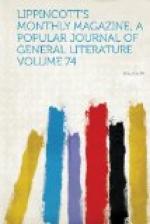Gustave Jacquet’s Le Minuet is one of those pictures which fascinate and draw us back again and again. A rarely-beautiful girl is dancing the minuet, surrounded by a group of her friends, beautiful blonde girls and a fair-haired young man. The costumes are perfectly exquisite, yet there is not too much chiffonnerie in the picture. There is a remarkable effect of depth in the painting of the figure of the dancing girl, especially at the feet and at the bottom of her skirt. Perhaps the only criticism that could fairly be passed upon M. Jacquet’s picture is that there is too much of mere “prettiness” about his principal figures.
A curious feature in this year’s exhibition is that there are three pictures of the assassination of Marat by Charlotte Corday, two of which are hung in the same room. There are also three paintings representing a scene from Victor Hugo’s Histoire d’un Crime, “L’enfant avait recu deux balles dans la tete.” The child is represented in Henry Gervex’s picture as being lifted up by his friends, who are examining the poor little wounded, bleeding head. It is powerful in composition and a very thrilling, realistic picture. The other two representations of this subject are by Paul Langlois and Paul Robert.
Gustave Courtois’s Dante and Virgil in Hell: The Circle of the Traitors to their Country, is a picture very much studied by all the artists who visit the Salon because of its strange landscape, its wonderful effect of the glacial formations and its marvellous effects of color. Benjamin Constant’s Les Derniers Rebelles is one of the best efforts of this artist, so fruitful in scenes drawn from Morocco and Egyptian life. He has depicted the sultan going forth in great splendor from the gates of the city of Morocco, surrounded by his army and courtiers, and before him are brought, either dead or alive, all the principal chiefs of the revolted tribes. There is much that is noble in the composition, and the coloring is perfect.
The arrangement of the pictures this year is not altogether satisfactory to the artists. A radical change has been made—grouping all the hors-concours men by themselves, and all the foreigners by themselves, and crowding about one thousand pictures out of doors into the corridors which run around the garden of the Palais de l’Industrie. A friend of mine saw a French artist mount a stepladder and deliberately cut out of the frame his picture and carry it away with him, because it was so badly hung.
The Illustrated Catalogue of the Salon is a somewhat remarkable work. It is specially noticeable for the very curious English translations of the titles of some of the paintings. For instance, the title of Gabriel Boutel’s picture, Bonne a tout faire—a soldier seated with a baby in his arms—is rendered, Maid for anything(!). Priere a Saint Janvier is rendered Prayer AT Saint Januarious. Le Cabaret du Pot d’Etain is translated The Tavern of the Brass POT (instead of Pewter Mug). Ed. Morin’s Promenade en Marne is A F_rip on the Marne!_ Our friend from Boston, Edwin Lord Weeks, is mentioned as “LORD” Edwin Weeks! But the best of all is La Cruche cassee, translated The Broken PIG! The title of another picture is (in the catalogue) Good-bye, SweeL hart!




